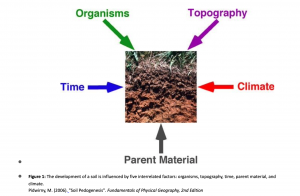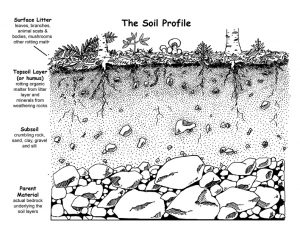AGRICULTURE Session 03: Where does Soil come from?
Learning Objectives
- Describe the geologic processes that form the parent material of soil specific to our South Carolina Upstate region.
- Evaluate the contributions of our geologic history to the process of soil formation (pedogenesis).
- Investigate soil composition, soil texture, and the properties of different soil types.
Background
- Pedogenesis can be defined as the process of soil development. Soil is a living part of the ecosystem containing thousands of microbes and organisms. The cycling of nitrogen and carbon in soils is almost completely controlled by the presence of animals and plants. Through litterfall and the process of decomposition, organisms add humus and nutrients to the soil which influences soil structure and fertility. Surface vegetation also protects the upper layers of a soil from erosion by way of binding the soil surface and reducing the speed of moving wind and water across the ground surface.
- Parent Material refers to the rock and mineral materials from which the soils develop. These materials can be derived from residual sediment due to the weathering of bedrock or from sediment transported into an area by way of the erosive forces of wind, water, or ice. Pedogenesis is often faster on transported sediments because the weathering of parent material usually takes a long period of time. The influence of parent material on pedogenesis is usually related to soil texture, soil chemistry, and nutrient cycling.

- Soil is naturally removed by the action of water or wind: such ‘background’ (or ‘geological’) soil erosion has been occurring for some 450 million years, since the first land plants formed the first soil. Even before this, natural processes moved loose rock, or regolith, off the Earth’s surface, just as has happened on the planet Mars.
- In general, background erosion removes soil at roughly the same rate as soil is formed. But ‘accelerated’ soil erosion — loss of soil at a much faster rate than it is formed — is a far more recent problem. It is always a result of mankind’s unwise actions, such as overgrazing or unsuitable cultivation practices. These leave the land unprotected and vulnerable. Then, during times of erosive rainfall or windstorms, soil may be detached, transported, and (possibly travelling a long distance) deposited.
- Accelerated soil erosion by water or wind may affect both agricultural areas and the natural environment, and is one of the most widespread of today’s environmental problems. It has impacts which are both on-site (at the place where the soil is detached) and off-site (wherever the eroded soil ends up).
- More recently still, the use of powerful agricultural implements has, in some parts of the world, led to damaging amounts of soil moving downslope merely under the action of gravity: this is so-called tillage erosion.
- Soil erosion is just one form of soil degradation. Other kinds of soil degradation include salinisation, (salts from fertilizers), nutrient loss, and compaction.
- Our SC Soils started out with parent material that was formed ~300 million years ago when the continents of Africa and North America collided and formed the Appalachian Mountain chain of which the Blue Ridge Mountains are a part. Originally as high as Mt.Everest (29,000 feet), our mountains are some of the oldest on the planet and have since eroded away over time to create our soils. The highest mountain in the Appalachians today is in NC, Mt.Mitchell= 6,684 feet and in SC our tallest peak is Sassafras mtn.= 3,563 (Table Rock Mtn. in Table Rock State Park is 3124 feet and Ceasars Head is 3,215). These huge granite balds are metamorphic rock formed under the heat and pressure of those ancient continental collisions.
- The natural geologic and organic process of creating just 1 inch of good topsoil takes ~500 years. Through some historically poor agricultural practices, we washed away our topsoil in about 90 years (a few generations). Now we have a hard clay subsoil layer that must be amended to grow crops. Today, through science and research, farmers use sustainable agriculture practices to conserve our precious soil resources and can even improve soil health.
Materials and Resources
1. Soil erosion labSoil Lab.docx (1)
2. SoilWeb: A free app that can be downloaded onto Apple and Android devices. SoilWeb allows users to access GPS based, real-time USDA-NRCS soil survey data. Using your geographic location, this app retrieves soil type summaries, including soil series names and image profiles.
3. Buckets(could be gallon milk jugs) with different particle sizes(mulch, sand, pebbles, rock, topsoil)
4. Sloped paint pans (option: Lowes can donate)
5. Watering can (option: the garden box kits may include one)
5. Newspaper
6. Sharpie or masking tape
7. Crayons or colored pencils
8. Soil posters
9. Soil_profile

15min
Look at maps of soil types and identify the soil taxonomy for their county.
Soil video
Content Lesson and Activities: ~60 minutes
30min
The learners will do the soil erosion lab (30 min erosion lab and 30 minutes putting the garden together by utilizing the garden kit)
In person:
Suggestions for leaders:
1. Review vocabulary
2. Hand out Soil Profile (Learners can color the layers in class or take it home for homework)
3. Point out the nematode
4. Talk about the oxidation of Iron which makes our soils red/orange.
5. Leaders can mention our land use-history of poor agricultural practices that washed away most of our good topsoil into the Savannah River and into the Atlantic. That’s why we have such hard pan clay and have to “amend” the soil to grow anything. Has anyone ever tried to dig a hole? What did they find? Was their soil hard or soft? What color was it?
Soil Erosion lab steps:
1. Dump some of the different particle sizes (clay, river rock,pebbles,sand,potting soil,mulch) on the newspaper. Let them explore with their hands and eyes. It’s fun to make messes ☺Have them discuss which materials are organic and which are inorganic.
2. Demonstrate erosion by having them layer the different soil particle sizes onto the elevated top half of the paint pan assimilating a lasagna layered vertical soil profile. Then use a pitcher or water can to simulate rain. Does the soil wash away? How do we prevent erosion? *you could find video of landslides on you tube. Suggest they use the layering order of the soil profile handout and add mulch for the surface litter layer. Then re-test with watering pitcher and see if they did a better job of keeping their soil in place the second time around.
- Option 1: Put together their garden utilizing the garden kit. It is approximately a 20 minute activity. They would be building without tools. Wooden raised beds.
- Option 2: Top off the soil on existing garden beds.
Virtual adaptation: The links below provide options for simple alternative soil activities for the leaders.
Soils4kids
Home and Garden Information Center
Closing Activity: ~15 minutes
Journal prompt: Soil is one of our most precious natural resources. What are some threats to soil conservation?
Source:
Figure 1: Pidwirny, M. (2006). “Soil Pedogenesis”. Fundamentals of Physical Geography, 2nd Edition Erosion
Peekaboo Kidz
SoilWeb
Media Attributions
- 5_factors
- soil_profile

